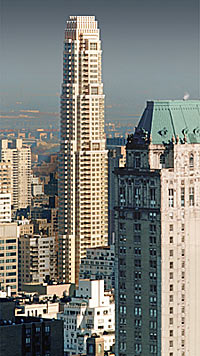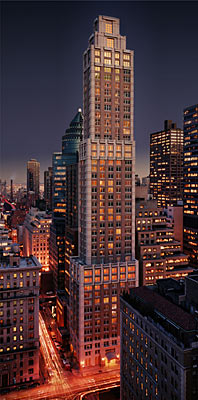|
Usually “famous” accompanies “successful” when we talk about architects with a substantial body of work in their portfolios. Frank Williams, FAIA, who died from esophageal cancer February 25, in New York City, was definitely successful. At 73, he could claim credit as the lead architect or the collaborating one for at least 20 high-rises in New York City. In Moscow, his 70-story Mercury City tower is nearing completion, while towers in Dubai, Seoul, are in the works. Yet Williams was hardly a household name.
Fame—even notoriety—eluded the architect trained at Berkeley (B.Arch. 1961) and Harvard’s Graduate School of Design (MAUD, 1965). Part of the reason may be that he specialized in high-end hotels and apartment houses. As architects know too well, public—and media—attention stays riveted on museums, performing arts halls, and single-family houses, all of which usually allow, and often encourage, high-budget fanciful explorations.
And if Williams’ designs were not edgy or innovative, his personal demeanor was quieter and more laid back than that of his colleagues. “Frank made people feel at ease,” says Michael Crosbie, who wrote the monograph The Architecture of Frank Williams in 1995, adding that Williams’ dignified persona seemed to correlate closely with his architectural style.
Williams entered the architecture profession with a city-planning agenda: as a consultant to the Regional Plan Association in New York, he and Rai Okamoto (also a consultant) were the authors of Urban Design Manhattan (1969), an influential study that proposed ways to handle growth in an already dense Midtown Manhattan. The timing was right: the book came out during Mayor Lindsay’s tenure, when his Urban Design Group was devising strategies to keep businesses (and families) from fleeing the crowded, unlivable urban core for the suburbs.
During the 1970s when the recession pummeled New York City, ambitious planning schemes were put aside. In 1977, Williams joined up with architect Theodore Liebman, FAIA, and others to design large-scale projects in Iran, under the firm name Haus (Housing and Urban Services) International. All was fine until Shah Pahlavi was deposed in 1979. Then Williams, in partnership with Liebman (Liebman, Williams, and Ellis) attracted William Zeckendorf Sr. as a client for the Columbia (1983)—an apartment house at 96th and Broadway now praised in guidebooks for its massing and layouts. Subsequently, Williams formed his own office and began working with Zeckendorf Development on luxury high-rise apartment towers.
Other developers came calling. Williams showed he could swim with the sharks without being ingested by hungry real-estate moguls. Indeed, Donald Trump praised his architecture for its design detail in the magazine, The Real Deal, in 2007: Williams had converted the Barbizon Plaza Hotel into Trump Parc (1988), then designed Trump Palace at 69th and Third Avenue (1992). He also designed 515 Park Avenue (2000) for Zeckendorf Development, plus other towers for Madison Equities and the Monian Group, Yet his office was small—averaging about 25. “Frank was intensely focused,” says Liebman. “He proved one could do large scale work without having a huge firm.”
Architect Sophia Gruzdys notes that Williams “was always absorbed in solving the problem, carefully considering proportions, scale, and detail.” Crosbie agrees, adding that “Williams was not doctrinaire,” perhaps owing to the early influence of revisionist-modernist Charles Moore who had taught Williams when he was a student at Berkeley.
Instead of “signature” architecture—the big whammies—Williams leaves behind very presentable buildings that quickly have become part of the city backdrop. Neither they, nor he, are famous. But they avoid the formulaic banality that characterizes so much of New York’s skyline: they form a tier of their own.
Williams is survived by his first wife Susan, second wife Veronica, and son David, who, trained as an architect heads formed 7th Art , a marketing firm, plus two grandchildren.






Post a comment to this article
Report Abusive Comment